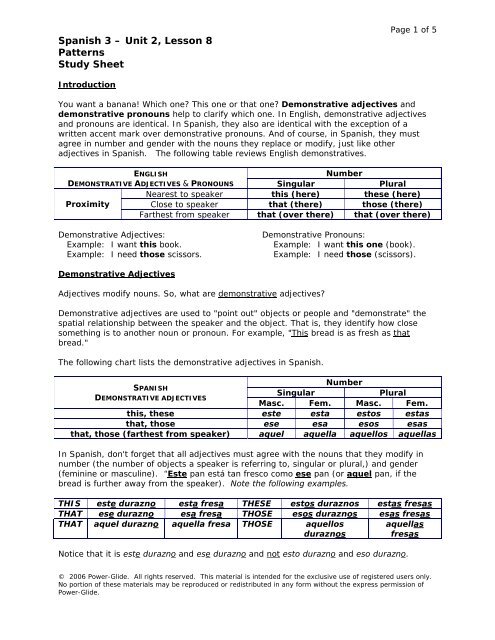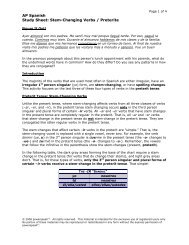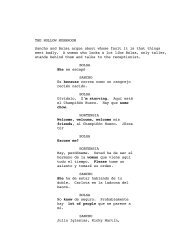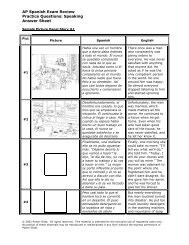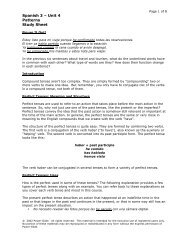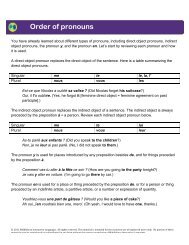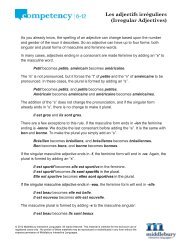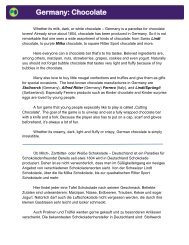Spanish 3 – Unit 2, Lesson 8 Patterns Study Sheet
Spanish 3 – Unit 2, Lesson 8 Patterns Study Sheet
Spanish 3 – Unit 2, Lesson 8 Patterns Study Sheet
Create successful ePaper yourself
Turn your PDF publications into a flip-book with our unique Google optimized e-Paper software.
<strong>Spanish</strong> 3 <strong>–</strong> <strong>Unit</strong> 2, <strong>Lesson</strong> 8<br />
<strong>Patterns</strong><br />
<strong>Study</strong> <strong>Sheet</strong><br />
Introduction<br />
Page 1 of 5<br />
You want a banana! Which one? This one or that one? Demonstrative adjectives and<br />
demonstrative pronouns help to clarify which one. In English, demonstrative adjectives<br />
and pronouns are identical. In <strong>Spanish</strong>, they also are identical with the exception of a<br />
written accent mark over demonstrative pronouns. And of course, in <strong>Spanish</strong>, they must<br />
agree in number and gender with the nouns they replace or modify, just like other<br />
adjectives in <strong>Spanish</strong>. The following table reviews English demonstratives.<br />
ENGLISH<br />
Number<br />
DEMONSTRATIVE ADJECTIVES & PRONOUNS Singular Plural<br />
Nearest to speaker this (here) these (here)<br />
Proximity<br />
Close to speaker that (there) those (there)<br />
Farthest from speaker that (over there) that (over there)<br />
Demonstrative Adjectives: Demonstrative Pronouns:<br />
Example: I want this book. Example: I want this one (book).<br />
Example: I need those scissors. Example: I need those (scissors).<br />
Demonstrative Adjectives<br />
Adjectives modify nouns. So, what are demonstrative adjectives?<br />
Demonstrative adjectives are used to "point out" objects or people and "demonstrate" the<br />
spatial relationship between the speaker and the object. That is, they identify how close<br />
something is to another noun or pronoun. For example, "This bread is as fresh as that<br />
bread."<br />
The following chart lists the demonstrative adjectives in <strong>Spanish</strong>.<br />
SPANISH<br />
DEMONSTRATIVE ADJECTIVES<br />
Number<br />
Singular Plural<br />
Masc. Fem. Masc. Fem.<br />
this, these este esta estos estas<br />
that, those ese esa esos esas<br />
that, those (farthest from speaker) aquel aquella aquellos aquellas<br />
In <strong>Spanish</strong>, don't forget that all adjectives must agree with the nouns that they modify in<br />
number (the number of objects a speaker is referring to, singular or plural,) and gender<br />
(feminine or masculine). “Este pan está tan fresco como ese pan (or aquel pan, if the<br />
bread is further away from the speaker). Note the following examples.<br />
THIS este durazno esta fresa THESE estos duraznos estas fresas<br />
THAT ese durazno esa fresa THOSE esos duraznos esas fresas<br />
THAT aquel durazno aquella fresa THOSE aquellos<br />
aquellas<br />
duraznos<br />
fresas<br />
Notice that it is este durazno and ese durazno and not esto durazno and eso durazno.<br />
© 2006 Power-Glide. All rights reserved. This material is intended for the exclusive use of registered users only.<br />
No portion of these materials may be reproduced or redistributed in any form without the express permission of<br />
Power-Glide.
<strong>Spanish</strong> 3 <strong>–</strong> <strong>Unit</strong> 2, <strong>Lesson</strong> 8<br />
<strong>Patterns</strong><br />
<strong>Study</strong> <strong>Sheet</strong><br />
Page 2 of 5<br />
Demonstrative Adjective Practice Exercise: Translate the word in quotes. Make sure it<br />
agrees with the noun.<br />
1. “this” casa<br />
2. “these” fresas<br />
3. “this” teléfono<br />
3. “that” libro<br />
4. “those” hombres<br />
5. “that” chica<br />
6. “those” chicos<br />
7. “those” manzanas (over there, or far away)<br />
8. “that” señor (over there, or far away)<br />
Now, scroll down and check your answers.<br />
1. esta casa <strong>–</strong> notice that esta is feminine because casa is feminine<br />
2. estas fresas <strong>–</strong> notice that estas is feminine and plural<br />
3. este teléfono <strong>–</strong> notice that the masculine singular form ends in a “e” not “o”<br />
4. ese libro <strong>–</strong> ese means that, still close to the speaker<br />
5. esa chica <strong>–</strong> esa ends in an “a” because chica is feminine<br />
6. esos chicos <strong>–</strong> notice that the noun is masculine and plural<br />
7. aquellas manzanas <strong>–</strong> feminine & plural, the apples are farther from the speaker<br />
8. aquel señor <strong>–</strong> the man is far from the speaker<br />
Demonstrative Pronouns<br />
Pronouns take the place of nouns. So, what are demonstrative pronouns?<br />
Demonstrative pronouns look just like demonstrative adjectives except that they have a<br />
written accent mark on the first é. The accent replaces the noun.<br />
—Yo quiero aquella pera grande. I want that big pear.<br />
—¿Cuál? ¿Ésta? Which one? This one?<br />
—No. Ésa. La verde a la izquierda. No. That one. The green one on the left.<br />
In the brief dialogue above between a customer and a produce merchant, the accent over<br />
ésta and ésa replaced the word pera. There was no need to repeat “pera” because both<br />
speakers knew what item they were talking about. Notice that in English we typically use<br />
the word “one” instead of an accent mark.<br />
SPANISH<br />
DEMONSTRATIVE PRONOUNS<br />
Number<br />
Singular Plural<br />
Masc. Fem. Masc. Fem.<br />
THIS (one), THESE (ones) éste ésta éstos éstas<br />
THAT (one), THOSE (ones) ése ésa ésos ésas<br />
THAT (one) over there,<br />
THOSE (ones) over there<br />
áquél aquélla aquéllos aquéllas<br />
© 2006 Power-Glide. All rights reserved. This material is intended for the exclusive use of registered users only.<br />
No portion of these materials may be reproduced or redistributed in any form without the express permission of<br />
Power-Glide.
<strong>Spanish</strong> 3 <strong>–</strong> <strong>Unit</strong> 2, <strong>Lesson</strong> 8<br />
<strong>Patterns</strong><br />
<strong>Study</strong> <strong>Sheet</strong><br />
Page 3 of 5<br />
You should note that you CANNOT use a demonstrative pronoun without having previously<br />
named the noun that it is replacing or unless it is clear in the context. Otherwise, no one<br />
will understand what object you are referring to.<br />
Demonstrative Pronoun Practice Exercise: Answer with the appropriate pronoun.<br />
1. --¿Quiere Ud. comprar esta falda? --No, gracias. Prefiero “that one.”<br />
2. --¿Te gustan esos zapatos? --Sí, me gustan “those.”<br />
3. --Prefieres este abrigo o ése? --Prefiero “this one.”<br />
4. --¿Qué tienda te gusta más? --“This one,” la joyería, por supuesto.<br />
Now, scroll down and check your answers.<br />
1. ésa <strong>–</strong> that one, The accent replaces falda.<br />
2. ésos -- those, the accent replaces zapatos.<br />
3. éste <strong>–</strong> this one, the accent replaces abrigo.<br />
4. ésta <strong>–</strong> tienda is the understood noun so “this one” should be feminine.<br />
NEUTER -- Each demonstrative pronoun also has a neuter or neutral form. It is used to<br />
refer to abstract ideas, a previously mentioned statement, or something vague like an<br />
unknown or unidentified object. The neuter pronouns do not change for number or gender,<br />
and they do not have a written accent.<br />
• esto (this idea, this thing)<br />
• eso (that idea, that thing)<br />
• aquello (that idea/thing over there)<br />
¡Esto es importante! This generic idea or concept is important!<br />
¿Qué es eso? What is that? -- the object is unknown<br />
Using Demonstrative Pronouns and Demonstrative Adjectives Together<br />
Demonstrative pronouns and demonstrative adjectives can be used together in the same<br />
sentence. All you have to remember is that they must agree in person, number, and gender<br />
with the noun(s) they replace or modify, and that in order to use a demonstrative pronoun,<br />
you must have previously mentioned the noun that you are replacing. For example:<br />
Estas ciruelas son grandes; ésas son pequeñas.<br />
(These plums is large; that one there is small.)<br />
and<br />
Aquella fruta es amarga, pero ésta es dulce.<br />
(That fruit over there is bitter, but this is sweet.)<br />
© 2006 Power-Glide. All rights reserved. This material is intended for the exclusive use of registered users only.<br />
No portion of these materials may be reproduced or redistributed in any form without the express permission of<br />
Power-Glide.
<strong>Spanish</strong> 3 <strong>–</strong> <strong>Unit</strong> 2, <strong>Lesson</strong> 8<br />
<strong>Patterns</strong><br />
<strong>Study</strong> <strong>Sheet</strong><br />
Practice Exercises<br />
Page 4 of 5<br />
To check your understanding of demonstrative pronouns and demonstrative adjectives,<br />
complete the following exercises.<br />
A. Sentence Completion: Demonstrative Adjectives<br />
Write the appropriate form of the demonstrative pronoun in the space provided. The<br />
masculine singular form of the demonstrative is provided in parentheses. Pay careful<br />
attention to the gender and number of the noun it replaces.<br />
1. __________ (Este) casa es hermosa.<br />
2. __________ (Ese) bolígrafo escribe bien.<br />
3. __________ (Aquel) libro contiene gramática española.<br />
4. __________ (Este) tienda es de mi tío.<br />
5. __________ (Ese) calles son estrechas (narrow).<br />
6. __________ (Aquel) soldado es valiente.<br />
7. __________ (Ese) mujer es inglesa.<br />
8. __________ (Este) hombres son corteses.<br />
9. __________ (Aquel) chico es portugués.<br />
10. __________ (Ese) flores son raras.<br />
11. __________ (Este) camisa es largísima.<br />
12. __________ (Aquel) carnicería vende la mejor carne.<br />
13. __________ (Este) reloj es un Rolex.<br />
14. __________ (Aquel) computadora no funciona bien.<br />
15. __________ (Ese) programas son buenos. *remember the rule for words ending in -ama<br />
B. Sentence Completion: Demonstrative Pronouns<br />
Circle the appropriate demonstrative pronoun in the parenthesis. Pay careful attention to<br />
the noun it replaces.<br />
1. Prefiero la corbata roja, no (ése, ésa, esa) que está allí.<br />
2. Me gusta aquella casa blanca, pero (éste, ésta, éstas) amarilla, no tanto.<br />
3. Esas manzanas ahí están deliciosas, pero (éste, éstas, éstos) no están tan buenas.<br />
4. Me gusta aquel automóvil pero (ése, ésa, ésos) que está allí es padrísimo (super cool).<br />
5. Este chaleco es chévere (cool) pero (aquel, aquél, aquélla) que lleva el señor allá es<br />
feo.<br />
6. Las montañas detrás de la universidad son bonitas pero (aquél, aquéllas, aquéllos)<br />
son desoladas.<br />
7. Prefiero las fresas del estado de Oregón no (ésas, ésa, ése) de California.<br />
8. El equipo vestido de azul es más talentoso que (éste, ésta, este) en rojo.<br />
9. Aquellos cuadros de Picasso me caen mucho mejor que (este, éstas, éstos) de Dalí.<br />
10. Preferimos las uvas verdes, no (éstas, ésta, éstos) moradas.<br />
11. La ropa hecha en Honduras es más barata que (aquél, aquélla, aquéllas) hecha en<br />
Nueva York.<br />
12. Las zanahorias del supermercado son mejores que (éstos, éstas, éste).<br />
© 2006 Power-Glide. All rights reserved. This material is intended for the exclusive use of registered users only.<br />
No portion of these materials may be reproduced or redistributed in any form without the express permission of<br />
Power-Glide.
<strong>Spanish</strong> 3 <strong>–</strong> <strong>Unit</strong> 2, <strong>Lesson</strong> 8<br />
<strong>Patterns</strong><br />
<strong>Study</strong> <strong>Sheet</strong><br />
Page 5 of 5<br />
C. Phrase Translation: Demonstrative Pronouns and Demonstrative Adjectives<br />
Translate each of the following phrases. Do not translate the words that are in parenthesis <strong>–</strong><br />
they are only there to help you identify the distance from the speaker. Make sure to add an<br />
accent to the demonstrative pronoun or the noun with the demonstrative adjective.<br />
1. those flowers (nearby)<br />
2. that drugstore (nearby)<br />
3. this (apricot right here)<br />
4. those (shoes way over there)<br />
5. these books (right here)<br />
6. those clothes (nearby)<br />
7. these apples (right here)<br />
8. this map of Spain (right here)<br />
9. those rivers (way over there)<br />
10. that (bread nearby)<br />
11. these (foods right here)<br />
12. that (backpack way over there)<br />
13. these (trees right here)<br />
14. this year<br />
15. that thing (nearby)<br />
D. Translation<br />
Translate each of the following phrases.<br />
Example: I prefer this tie not that one (nearby). Prefiero esta corbata, no ésa.<br />
1. I need this price, not that one.<br />
2. That class (over there) is bigger than<br />
this one.<br />
3. I like this watch, not that one (nearby).<br />
4.<br />
5. Those shoes (over there) are more<br />
expensive than these.<br />
6. That is difficult. (unspecified idea)<br />
7. These exercises are easier than those.<br />
8. What is this? (unidentified object)<br />
E. Writing Exercise<br />
Write a dialogue in the store of your choice using at least six sentences. You and a friend<br />
are deciding between two or three different objects. Be sure to use words like this, these,<br />
that, those, and those over there.<br />
© 2006 Power-Glide. All rights reserved. This material is intended for the exclusive use of registered users only.<br />
No portion of these materials may be reproduced or redistributed in any form without the express permission of<br />
Power-Glide.


